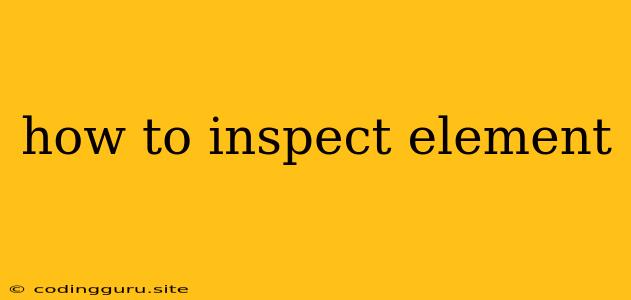How to Inspect Elements: A Beginner's Guide to Web Development
Have you ever looked at a website and wondered how they made that cool effect, or how they designed that beautiful layout? Perhaps you've even tried to recreate it yourself, only to find yourself lost in a sea of confusing code. Fear not, fellow web enthusiast! The answer lies in the power of inspect element.
Inspect element, a powerful tool built into your web browser, gives you the ability to delve deep into the inner workings of any webpage. It lets you see the HTML structure, CSS styling, and JavaScript code that brings the website to life. This knowledge is crucial for web developers, designers, and anyone who wants to understand how websites are built.
Why Should You Learn to Inspect Elements?
Here are a few compelling reasons why mastering inspect element is a valuable skill:
- Understand Website Structure: You can see exactly how the elements on a website are arranged, including their tags, classes, and IDs. This is invaluable for replicating the look and feel of a website, or for identifying issues in your own web development projects.
- Analyze CSS Styling: Explore how the CSS code controls the appearance of elements on a webpage. This lets you experiment with different styles, learn from how others style their websites, and even debug your own CSS code.
- Explore JavaScript Functionality: Investigate the JavaScript code that powers the interactive elements of a webpage, such as animations, forms, and user interactions. This understanding will help you write more effective JavaScript code and learn from the approaches used by others.
- Debug Website Issues: When you encounter a bug or a strange behavior on a webpage, inspect element can pinpoint the exact line of code causing the problem. It's an essential tool for any web developer or designer.
How to Inspect an Element: A Step-by-Step Guide
Here's how to access the inspect element tool in your browser:
- Right-Click the Element: Open your browser and visit the website you want to inspect. Right-click on the specific element you are interested in (for example, a button, a text block, or an image).
- Choose "Inspect" or "Inspect Element": In most browsers, you'll find the "Inspect" or "Inspect Element" option in the right-click menu. Select it to open the developer tools.
- The Developer Tools: The inspect element tool will typically appear in a separate window or panel, often at the bottom of the browser window. This is where you can explore the HTML structure, CSS styles, and JavaScript code associated with the selected element.
Navigating the Developer Tools: A Tour of the Inspect Element Interface
The exact interface of the developer tools will vary slightly depending on the browser you are using (Chrome, Firefox, Safari, Edge), but they all share the same core functionality. Here's a quick overview of the key sections:
- Elements Panel: The "Elements" panel displays the HTML structure of the webpage, showing the different elements, their attributes, and their nesting. It is often the most commonly used part of the inspect element tool.
- Styles Panel: The "Styles" panel shows all the CSS rules that are applied to the selected element. You can see the style properties (like font size, color, and background color) and their values. It's a great way to understand how elements are being styled and to experiment with different styles.
- Console Panel: The "Console" panel is used for logging messages, running JavaScript code, and debugging web applications.
- Network Panel: The "Network" panel provides insights into the resources that are loaded when the webpage is accessed, such as images, scripts, and CSS files. It can be very helpful for identifying performance issues.
Tips for Effective Inspect Element Usage
- Use the Selector Tools: The developer tools often include a selector tool that allows you to quickly select an element on the page by hovering over it with your mouse. This is a much faster way to inspect elements compared to right-clicking and then navigating through the "Elements" panel.
- Experiment with Styles: Don't just read the CSS; change it! Try adjusting font sizes, colors, and other properties to see how the changes affect the selected element. This hands-on approach is a great way to learn about CSS styling and to understand how websites are designed.
- Inspect JavaScript Events: Examine the JavaScript code that is triggered when you interact with elements on the page, like clicking on a button or hovering over a link. Look for event listeners and functions that are being called.
- Use the Search Function: When working with large websites, it can be challenging to locate specific elements in the "Elements" panel. Use the search function to find specific elements by their ID, class name, or tag name.
- Explore More than Just Styles: Remember, inspect element gives you access to more than just the styling of a webpage. Explore the HTML structure and the underlying JavaScript code to gain a comprehensive understanding of how the website is put together.
Conclusion
Mastering inspect element is a fundamental skill for web developers and designers, and even for anyone interested in understanding how the web works. It empowers you to see the underlying code, experiment with styling, and debug website issues. So, get out there and start exploring! The world of web development awaits.
